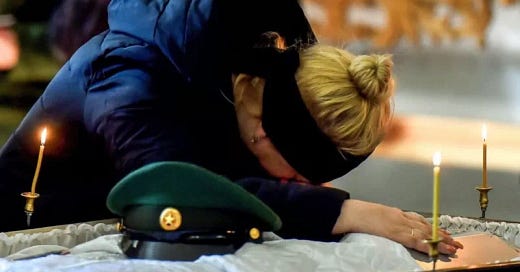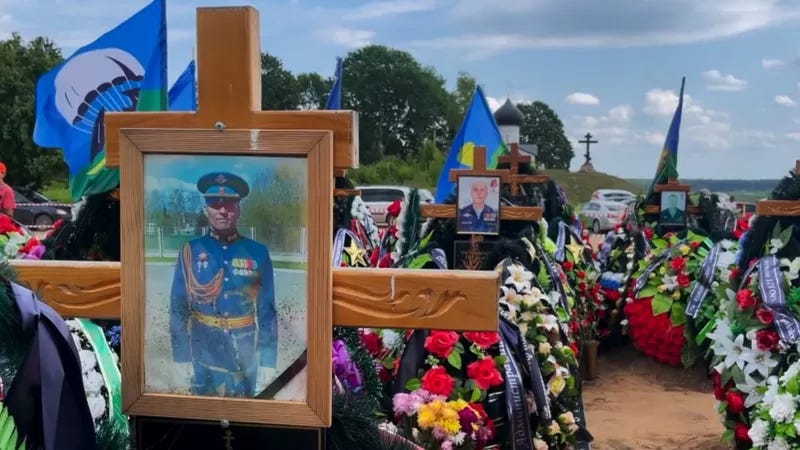Lost battalions: calculating Russia's casualties in six months of war in Ukraine
BBC Russian's analysis shows that junior officers are killed much more frequently than those under their command in Russia's army in Ukraine.
By Olga Ivshina
As of August 19th, open source information has helped the BBC to identify the names of 5701 Russian soldiers killed in the war in Ukraine. Our analysis suggests particularly heavy losses among junior officers, who are killed much more frequently than those under their command.
BBC Russian, together with the MediaZona news outlet and a team of volunteers, have maintained a list of Russian military casualties. In it, we only include verified reports of deaths, so the figures don’t reflect the true level of losses.
But based on thousands of individual stories, we can start to get an understanding of what is happening to the Russian army as the invasion of their neighbouring country continues.
Information from cemeteries offers a sense of how many casualties have been missed by our record. Every week, in different population centres across Russia, we uncover new evidence of military funerals which have gone unreported by the authorities.
Based on our observations, we estimate that at least 40-60 per cent more soldiers have been buried in Russian graveyards than reflected in the figure shown by the BBC’s list of confirmed casualties.
Junior officers are least likely to survive
Of the 5701 identified Russian soldiers killed in Ukraine, 966 were officers – including four generals and 34 colonels. In other words, officers constitute 17 per cent of Russian fatalities. The data show that the heaviest losses were suffered by junior officers – three times more likely to die than their subordinates.
We were able to reach this conclusion by comparing the numbers of confirmed losses among officers and among soldiers. Each Russian junior officer is responsible for roughly 20 soldiers. Going with this ratio, for each of the 4735 privates, sergeants and corporals confirmed dead, there should be around 230 killed junior officers. In reality, the figure is three times higher.
In the last three weeks alone, over 80 personnel ranking from lieutenant to captain were killed. Arguably, there are several reasons for this. In the Russian army, junior officers have to make important tactical decisions to direct the course of combat. The majority of them are very young – often promoted to lieutenant at the age of 21 or 22 – and notwithstanding their inexperience, they have to find out for themselves how to achieve the goals set by the higher command.
Judging by the data, the majority of senior officers were killed during the first two months of the war. This is especially true of colonels. During this time, the Russian army was experiencing its most serious problems with logistics and communications, but was attacking from several directions at once.
Most likely, after channels of communication were established between headquarters and fighting units, colonels and generals began to make less frequent trips to the frontline – and consequently died less often.
The most recent report of the killing of a Russian general appeared in June. Ukrainian and Russian media mentioned the death of Roman Kutuzov, the commander of operations in the Luhansk region.
Fewer announcements, but more and more graves
The heads of the Russian regions are increasingly unlikely to publish the deaths of soldiers fighting in Ukraine. In the spring, almost all of them regularly shared such information. But since the end of May, many have stopped altogether.
In terms of confirmed losses, Dagestan, Buryatia and Krasnodar continue to take the lead with 270, 245 and 206 deaths respectively. By comparison, there have only been 14 confirmed casualties from Moscow - even though the capital is home to nine per cent of Russia’s population.
The BBC is continuing to monitor graveyards in different regions of Russia to gain a fuller picture of Russian losses in Ukraine.
Over the past six months, we have studied 45 graveyards in locations stretching from Kaliningrad on the Baltic Sea to Vladivostok in the Russian far east. In 41 of them, we found graves of servicemen whose deaths had not been publicly announced. In the last two weeks alone, we have revealed a further fifteen similar burials, including those of three officers.
Confirmed reports of casualties do not by a long stretch reflect the actual level of losses. Nonetheless, to give a rough idea of scale, we analysed the figure of 5701 deaths alongside the numerical size of Russian military units.
Open source information suggests that a Russian infantry battalion consists of between 150 and 500 men. The average is 300, and using this figure we can arrive at the conclusion that Russia has lost the equivalent of 19 to 20 battalions during the first six months of the invasion of Ukraine.
Citizens of other post-Soviet countries are also fighting and dying in Ukraine as soldiers of the Russian army. The BBC knows of the deaths of at least 13 natives of Kyrgyzstan, nine from Tajikistan, 12 from South Ossetia – the breakaway region of Georgia - and one from Moldova.
Paratroopers, infantrymen - and at least one convict
In terms of overall losses, infantrymen and paratroopers have been the hardest hit. As of August 18th, 20 per cent of all the identified dead served in the airborne units, and a further 20 per cent in motorised rifle units.
“To win a modern conflict, we need well-trained, mobile, motivated attack infantry,” one of Russia’s military experts notes. “And the Russian army has problems in this area. As a result, paratroopers, marines and Wagner Group mercenaries are called upon to resolve infantry tasks.”
The heavy losses among paratroopers can also be explained by the fact that airborne units were often left unsupported by regular troops and aviation. Experts interviewed by the BBC say such situations often transpired because of logistical problems and the failure of Russia to establish dominance in the air.
The group with the fastest-growing casualty rate consists of those termed ‘volunteers’ by the Russian media and officials. More often than not, the category includes men over the age of 40 from regions with a low average salary.
Before being despatched to the front, units of ‘volunteers’ undergo between three and seven days of training. Nevertheless, ‘volunteers’ now represent one of the main assault forces on the Russian frontline.
Over the past three weeks, the number of confirmed losses among Rosgvardiya - the Russian National Guard - has also increased. As of August 19th, there were 231 deaths recorded among such servicemen, dozens of whom fought in special forces units considered the best in Russia.
Reports of the deaths of at least 66 fighter pilots have also been verified. These are one-off specialists, the elite of any military in the world.
Over the past two weeks, Russian state media confirmed that at least one prisoner who fought in a Russian paramilitary unit had died in Ukraine. Konstantin Tulinov, serving time for participating in the torture of detainees, was killed on July 14th. The ‘Gulagu.net’ website was the first to report the recruitment of Russian prisoners for frontline action. Journalists from other publications have also written about the practice.
What is the genuine number of casualties?
Taking into account information from Russian graveyards, the list of confirmed casualties compiled by the BBC may include less than half the true number of Russian soldiers killed in Ukraine - and buried in Russia.
According to the CIA, Russia had lost by the end of July more than 15,000 troops in Ukraine. British intelligence talked of a figure of 20,000 as early as June. The General Staff of the Ukrainian Armed Forces, meanwhile, reckons Russia has lost more than 44,000 soldiers and officers.
Such a broad spread of figures may be explained by the differing terminology or methods of calculation.
For example, Ukraine counts losses amongst soldiers of the self-styled Donetsk and Luhansk People’s Republics as ‘Russian losses,’ and also includes casualties from private military companies. The total losses in these two categories are in the thousands. In the Donetsk People’s Republic alone, the self-proclaimed leaders have recognised the deaths of more than 2600 soldiers.
The final figure also increases sharply if the list of casualties includes all military personnel from Russia and the ‘people's militias’ of Donetsk and Luhansk who are missing in action.
The number of missing Russians cannot be established even approximately. But in a search of online groups for supporters of the Donetsk and Luhansk People’s Republics, the BBC found more than 3200 posts from people searching for male relatives who had joined the ranks of the ‘people’s militias’ but had not been in contact for a long time.
On the Russian side, up-to-date official statistics do not exist. The Russian Ministry of Defence last reported their losses – 1351 dead – on March 25th.
The BBC is continuing to gather data on military casualties. If you would like to share information, please contact us via this link.
Our methodology
New lists of the dead, and photos from funerals, are published in Russia every day. Generally, names are announced by the heads of Russian regions, or by representatives of district administrations; or by local media and the educational institutions where the deceased studied, as well as by their relatives.
The BBC and a team of volunteers are studying this data, adding it to a database we have maintained from the start of the Russian invasion of Ukraine.
We do not count media reports of dozens, sometimes hundreds, of casualties, if we do not have specific information about names and surnames. Nor do we count the deaths of Russians who served in the armies of the self-proclaimed republics of Donbass prior to February 24th, or the losses of fighters from the so-called Wagner Private Military Company.
Translated by Pippa Crawford.
Read this story in Russian here.







